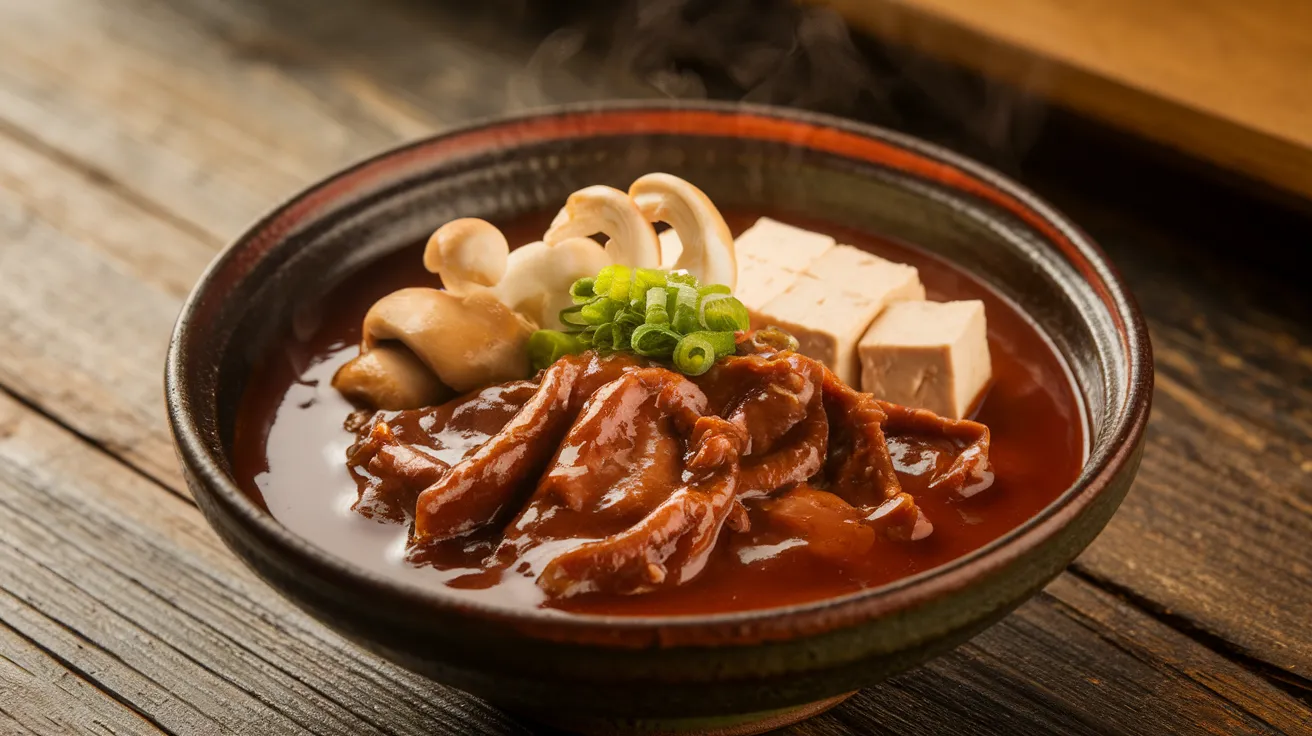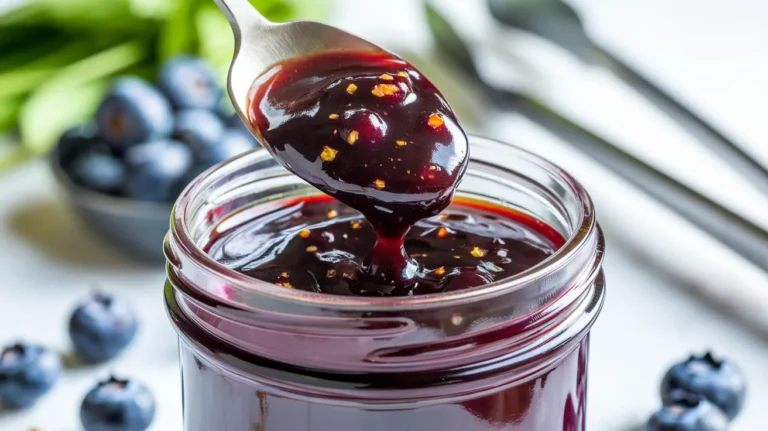This rich, savory sukiyaki sauce transforms your Japanese hot pot into an authentic dining experience with its perfect balance of sweet and umami flavors. Made with simple pantry ingredients, this sukiyaki sauce recipe delivers restaurant-quality results that will have your family asking for seconds at every meal.
SERVES: 4 | PREP: 5 MIN | COOK: 8 MIN | TOTAL: 13 MIN
Ingredients
Base Sauce Components
| Ingredient | Amount | Notes |
|---|---|---|
| Soy sauce | 1/2 cup | Use low-sodium for better control |
| Mirin | 1/4 cup | Sweet rice wine essential for authenticity |
| Sake | 2 tablespoons | Adds depth and complexity |
| Sugar | 3 tablespoons | Granulated white sugar works best |
| Water | 1/4 cup | For proper consistency |
Flavor Enhancers
| Ingredient | Amount | Purpose |
|---|---|---|
| Kombu seaweed | 1 piece (2-inch) | Natural umami booster |
| Fresh ginger | 1 teaspoon grated | Adds warmth and brightness |
Step-by-Step Instructions
Phase 1: Preparation (2 minutes)
Step 1: Gather all ingredients on your counter and measure each component into separate small bowls. This mise en place approach prevents mistakes and ensures smooth cooking since the sauce comes together quickly.
Step 2: Grate the fresh ginger using a fine microplane grater. Fresh ginger is crucial here because it provides a clean, sharp flavor that ground ginger simply cannot match in this sukiyaki sauce.
Phase 2: Building the Base (3 minutes)
Step 3: Pour the soy sauce into a medium saucepan and place over medium-low heat. Start with low heat to prevent the sauce from becoming too salty through rapid evaporation.
Step 4: Add the mirin to the soy sauce and stir gently with a wooden spoon. The mirin’s natural sweetness will begin to meld with the soy sauce, creating the foundation of authentic sukiyaki sauce flavor.
Step 5: Pour in the sake and water, stirring to combine all liquid ingredients evenly. The sake adds complexity while the water helps achieve the proper consistency for coating your sukiyaki ingredients.
Phase 3: Sweetening and Seasoning (4 minutes)
Step 6: Add the sugar to the liquid mixture and stir continuously until completely dissolved. Watch for the sugar to disappear entirely – this usually takes about 2 minutes of gentle stirring.
Step 7: Drop the kombu seaweed piece into the sauce and let it steep as the mixture heats. The kombu will release natural glutamates that give your sukiyaki sauce its signature umami depth.
Step 8: Add the grated ginger and stir it throughout the sauce. The heat will release the ginger’s aromatic oils, infusing the entire batch with subtle warmth.
Phase 4: Simmering to Perfection (4 minutes)
Step 9: Bring the sukiyaki sauce to a gentle simmer over medium heat. You’ll see small bubbles forming around the edges – this is perfect. Avoid a rolling boil which can make the sauce too concentrated.
Step 10: Reduce heat to low and simmer for 3-4 minutes, stirring occasionally. The sauce should reduce slightly and develop a glossy appearance that coats the back of your spoon.
Step 11: Remove the kombu piece using tongs or a spoon. The seaweed has done its job of adding umami – leaving it longer can make the sauce too oceanic in flavor.
Step 12: Taste your sukiyaki sauce and adjust sweetness if needed. Add an extra teaspoon of sugar for sweeter preference, or a splash more soy sauce for deeper savory notes.
Chef’s Notes
Professional Tip #1: The key to exceptional sukiyaki sauce lies in the balance between sweet and salty. Start conservative with sugar additions – you can always add more, but you cannot take it away.
Professional Tip #2: Quality mirin makes a noticeable difference in your finished sukiyaki sauce. Look for hon-mirin (true mirin) rather than mirin-flavored seasoning for the most authentic results.
Professional Tip #3: This sauce stores beautifully in the refrigerator for up to two weeks, making it perfect for multiple sukiyaki dinners or other Japanese cooking applications.
Professional Tip #4: For deeper flavor complexity, let your sukiyaki sauce cool completely before serving. The flavors meld and intensify during the cooling process, creating a more harmonious taste.
Nutrition Information (Per 2-tablespoon serving)
- Calories: 45
- Protein: 2g
- Carbohydrates: 9g
- Fat: 0g
- Sodium: 680mg
Delicious Variations
Spicy Sukiyaki Sauce: Add 1 teaspoon of togarashi (Japanese seven spice) or a pinch of red pepper flakes during the simmering phase for heat that complements the sweet-savory base.
Garlic-Enhanced Version: Include 2 minced garlic cloves with the ginger in step 8. The garlic adds aromatic depth that pairs wonderfully with beef sukiyaki.
Mushroom Sukiyaki Sauce: Steep 3-4 dried shiitake mushrooms in the sauce during simmering, then remove before serving. This creates an earthier profile perfect for vegetarian sukiyaki. For more Japanese sauce inspiration, try this tempura dipping sauce that uses similar flavor principles.
Rich Dashi Version: Replace the water with prepared dashi stock for an even more umami-forward sukiyaki sauce that rivals high-end Japanese restaurants. This technique also works beautifully in shabu-shabu dipping sauce preparations.
Storage & Reheating Guide
Refrigerator Storage: Transfer cooled sukiyaki sauce to an airtight glass jar or container. Properly stored, it maintains peak flavor for 14 days in the refrigerator.
Freezing Instructions: This sauce freezes well for up to 3 months in ice cube trays. Once frozen solid, transfer cubes to a freezer bag for convenient single-serving portions.
Reheating Method: Warm gently in a small saucepan over low heat, stirring frequently. Add a tablespoon of water if the consistency becomes too thick after storage.
Room Temperature Use: For cold applications or as a finishing sauce, let refrigerated sukiyaki sauce come to room temperature for 30 minutes before serving.
Troubleshooting Common Issues
Problem 1: Sauce is too salty Solution: Add an extra tablespoon of sugar and 2 tablespoons of water. Simmer briefly to incorporate. The additional sweetness and dilution will balance the saltiness without compromising the sukiyaki sauce integrity.
Problem 2: Consistency is too thin Solution: Continue simmering uncovered for 2-3 additional minutes, stirring frequently. The sauce should coat a spoon lightly but not be syrupy thick.
Problem 3: Bitter aftertaste develops Solution: This usually happens from overheating or burning. Start fresh – sukiyaki sauce is quick enough that remaking is more efficient than trying to fix burnt flavors.
Problem 4: Sauce separates or looks oily Solution: Whisk vigorously while reheating. The ingredients naturally want to emulsify when properly heated and stirred.
Problem 5: Flavor tastes flat or one-dimensional Solution: Add a pinch of salt and a squeeze of fresh lemon juice. These small additions brighten all the other flavors in your sukiyaki sauce.
Equipment Essentials
- Medium saucepan (2-3 quart capacity)
- Wooden spoon for gentle stirring
- Fine microplane grater for fresh ginger
- Measuring cups and spoons
- Small mixing bowls for ingredient prep
- Tongs for kombu removal
- Storage jar with tight-fitting lid
Shopping List by Store Section
Asian Foods Aisle
- Soy sauce (low-sodium preferred)
- Mirin (hon-mirin if available)
- Sake (cooking grade acceptable)
- Kombu seaweed sheets
Baking Aisle
- Granulated white sugar
Produce Section
- Fresh ginger root
Pantry Staples
- Water (filtered preferred)
Success Secrets
1. Temperature Control is Everything: Keep heat at medium-low throughout cooking. High heat causes rapid evaporation and can make your sukiyaki sauce overly concentrated and salty.
2. Quality Ingredients Matter: Invest in good mirin and soy sauce. These two ingredients form the flavor backbone of your sukiyaki sauce, so premium versions create noticeably better results.
3. Timing the Kombu: Remove the seaweed after exactly 3-4 minutes of simmering. Longer steeping can make the sauce taste too oceanic and overpower the delicate sweet-savory balance.
4. Taste and Adjust: Always taste your sukiyaki sauce before final storage. Every brand of soy sauce has different salt levels, so final seasoning adjustments ensure perfect balance every time.
5. Make Ahead for Better Flavor: This sukiyaki sauce actually improves overnight in the refrigerator as all the flavors meld together. Make it a day ahead of your sukiyaki dinner for optimal taste.




